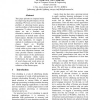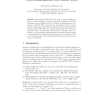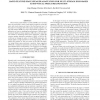ICIAP
1999
ACM
14 years 6 months ago
1999
ACM
In this work we propose a new supervised deformable model that generalizes the classical contour-based snake. This model is defined to deform in a feature space generated by a se...
NLPRS
2001
Springer
14 years 6 months ago
2001
Springer
This paper presents an empirical study for improving the performance of text chunking. We focus on two issues: the problem of selecting feature spaces, and the problem of alleviat...
ICANN
2001
Springer
14 years 6 months ago
2001
Springer
In manipulating data such as in supervised learning, we often extract new features from original features for the purpose of reducing the dimensions of feature space and achieving ...
GECCO
2003
Springer
14 years 7 months ago
2003
Springer
When using a Genetic Algorithm (GA) to optimize the feature space of pattern classification problems, the performance improvement is not only determined by the data set used, but a...
ECCV
2010
Springer
14 years 7 months ago
2010
Springer
Abstract. Finding point correspondences plays an important role in automatically building statistical shape models from a training set of 3D surfaces. For the point correspondence ...
EWCBR
2004
Springer
14 years 7 months ago
2004
Springer
Abstract. Good similarity functions are at the heart of effective case-based reasoning. However, the similarity functions that have been designed so far have been mostly linear, we...
ECAI
2004
Springer
14 years 7 months ago
2004
Springer
The standard SVM formulation for binary classification is based on the Hinge loss function, where errors are considered not correlated. Due to this, local information in the featu...
IJCNLP
2005
Springer
14 years 7 months ago
2005
Springer
Abstract. This paper presents our recent work on period disambiguation, the kernel problem in sentence boundary identification, with the maximum entropy (Maxent) model. A number o...
ICMCS
2005
IEEE
14 years 8 months ago
2005
IEEE
Multi-stream hidden Markov models (HMMs) have recently been very successful in audio-visual speech recognition, where the audio and visual streams are fused at the final decision...
ICMCS
2005
IEEE
14 years 8 months ago
2005
IEEE
In this work we propose an intuitive graphic framework for the effective visualization of MPEG-7 low-level features, in the context of classification and annotation of audio-visu...



